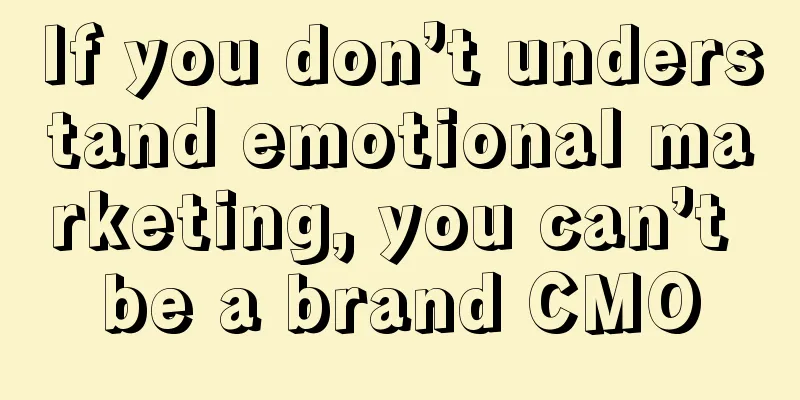If you don’t understand emotional marketing, you can’t be a brand CMO

During Double 11, many brands and IPs failed due to incorrect emotional values. The first is Li Jiaqi, a model of grassroots counterattack. He has been instilling the concept of "rational consumption, happy shopping" in netizens in his live broadcast room. His live broadcast room is always lively and full of various emotional values. However, some time ago, he chose to "backstab" consumers because he was too biased towards brands. Overnight, his reputation reversed sharply. This is all because Li Jiaqi stood on the brand's side during the live broadcast, expressed strong brand emotions, and criticized consumers' spending power, which led to netizens' disgust. Many girls who support Li Jiaqi are price-sensitive people, but they are labeled as "not working hard enough", which undoubtedly exacerbated the reversal of word-of-mouth. If we think about Li Jiaqi's car crash carefully, one of the important factors is the asymmetry of the cognition of "emotional value". Li Jiaqi believes that he is already financially free and continues to work live to bring additional emotional value to consumers, so he feels that consumers owe him. However, consumers believe that they have gained emotional value through shopping, which is a fair trade. The Li Jiaqi incident made us realize the importance of emotional value in modern business. In addition, Liu Run's annual speech about the discount MAMA store data also caused controversy. He initially refuted the doubts through his official account, but as the incident fermented, he finally realized that there were problems with the data in his speech and chose to apologize. In fact, whether it is Li Jiaqi’s reputation reversal or Liu Run’s data controversy, it reflects the close relationship between emotions and brands in modern business. 1. Analysis of brand cases of “emotion”In the business arena, a new battle has begun between emotions and brand marketing. Nike's slogan "just do it" is like a breeze blowing through the hearts of young people, encouraging them to boldly try and pursue themselves. This immediately resonated with consumers and created a wonderful resonance. Whether it is signing stars or advertising, every step of brand marketing is creating emotional value for consumers. Nike AJ1, which is made of more exquisite materials, has seen its market price drop to the bottom. Why? Because people think wearing AJ1 is not cool enough and not original. They have heard the story of Nike for too long, and the spark of interest has slowly extinguished. It can be seen that the fading of emotions has a direct impact on the demand for products. However, on the other hand, those extreme reversal and inspiring pictures can ignite consumers' desire to buy. So, many times, what we buy is not only the product, but also the emotion at that moment. In this era of material abundance, consumers are paying more and more attention to emotional value and the emotional symbols of brands. Especially for Generation Z, they care more about whether the products can resonate with people and help them express themselves. The brand HOTSUIT is very smart. It not only sells sports equipment, but also promotes a high-end sports lifestyle. Netizens have said: "Sweating during exercise is very stress-relieving, and fitness is more motivated!" As the creator of the current hot sports IP "Doubanhan Dopamine", HOTSUIT has turned sports into a party for all people. Of course, the magic of emotions is more than that. Coca-Cola's high growth comes from its successful grasp of the common needs of human beings - "dopamine emotions". This happy water makes everyone unable to stop. The same is true for Disney, Lego, Netflix, and our Chinese Miniso and Tik Tok. Healing anxiety and providing happiness, as long as you grasp the interests and emotions of consumers, growth will be a natural thing. In the just-concluded Q4 fiscal year of 2023, MINISO delivered a brilliant report card. Revenue increased by 40.3% year-on-year to 3.25 billion yuan, and adjusted net profit increased by 156% year-on-year. Ye Guofu, Chairman and CEO of MINISO Group, clearly pointed out: "The essence of consumption is happiness." This "emotional concept" has also made MINISO popular around the world. 2. The "Emotional Value Methodology" summarized in those yearsWe all know that “there is nothing new under the sun”, and the emotional value methodology can also be summarized. One is to study the emotional needs of consumer audiences. In fact, whether it is Coca-Cola’s “Happy Journey” or Airbnb’s “Love and Acceptance”, the brands have conducted in-depth research on the emotional needs of consumer audiences. For example, Coca-Cola understands consumers’ need for happiness and positive emotions, so it meets consumers’ emotional needs for sharing, happiness and friendship through interactive activities around the world. Airbnb, on the other hand, seizes people’s desire for belonging, acceptance and tolerance, and touches consumers’ emotions through real stories in advertisements. The second is the connection between brand stories and consumers. Brand stories are the key to establishing a deep connection between brands and consumers. For example, Nike’s “Just Do It” slogan and the stories of many athletes behind it encourage consumers to pursue their dreams and overcome difficulties, establishing a tenacious connection with consumers. Apple’s “Think Different” ad positions itself as a leader in innovation by showing great people who change the world, resonating with consumers’ emotions of pursuing difference. The third is personalized emotional needs. Meeting consumers' personalized emotional needs is the key to today's market. The popularity of ugly shoes has captured consumers' personalized pursuit of "difference". Beautiful things are all the same, but "ugly" things are one in a million. This reverse thinking just meets the personalized needs of some consumers and has therefore gained a huge market share. Also, be good at using social media, which is the bridge that connects brands and consumers emotionally. For example, Mixue Ice City's brainwashing slogans sparked discussion and sharing on social media, becoming a viral phenomenon. Luckin Coffee's "Crazy Morning" also used social media to vividly display the true emotions of office workers, which resonated with a large number of office workers. Emotional soft articles delivered by brands through social media are more likely to penetrate users' hearts and form emotional resonance. In summary, emotional marketing has become the core of modern brand strategy. Only brands that truly grasp consumers' emotions can form lasting brand loyalty and win market share. 3. The “core” of emotional valueThe core of emotional value is to understand the current emotions and perceive the "anger value" of consumers. Brands need to walk side by side with consumers and be more humble. Let brands and consumers have empathy, emotions, and value. In fact, in the bustling business world, it is not easy to establish a deep emotional connection between brands and consumers. But once this connection is established, it is the most precious tacit understanding. This tacit understanding, to put it bluntly, is empathy: you are not alone, we understand you. Speaking of empathy, we have to mention a brand that has emerged in recent years - Shuang Hotpot. In the crowded hotpot market, many brands are trying to find their own positioning. Haidilao has driven the popularity of the entire industry, and brands such as Banu, Dezhuang, Chaotianmen, Xiaolongkan, and Qinma are not to be outdone, and have made efforts to compete for the market and consumer attention. However, in such an environment, Shuang Hotpot has found its own differentiated positioning: happiness. Shuang Hotpot has seen through the inner labels of contemporary young people: "sense of ritual", "appearance is justice", "social phobia", "social bull attributes", and extracted its own spiritual core from them: forget the troubles and enjoy life in time. This core is similar to Disney's "happy" culture. The cute cartoon staff in the store, the happy way of serving dishes, and the slogans and cartoons of "Happiness Long Live" that can be seen everywhere have become a weapon to attract consumers. And this happy atmosphere has indeed infected many consumers, making Shuang Hotpot a hit in a short period of time. At the same time, many brands are also using emotional marketing to establish emotional connections with consumers by understanding their emotions. Whether it is "students" or "workers", these identity labels have become an effective means for brands to attract target customers. Emotions are not limited to joy, anger, sorrow, and happiness, but also include a series of complex emotional experiences. For example, young people burn incense, worship Buddha, and buy bracelets. In fact, they are not really becoming feudal and superstitious, but are more looking for spiritual comfort to solve current anxiety. The Huo Run Crystal Ball Yogurt under New Hope Dairy is also a good example. It has insight into the fact that when workers face the dual pressure of mental and economic pressure, although they say "lie down", they are actually still holding back their energy in their hearts. In response to this mentality, Huo Run Crystal Ball Yogurt combines the core selling point of the product "the survival rate of probiotics is increased by 1000+ times" with the common emotions of young people, and cooperates with the Little Blue IP to create content stories and focus on the daily life of the vast "worker group". This strategy not only demonstrates the upgrade of product functions, but also emotionally satisfies the needs of consumers, providing full vitality for workers and helping them "lie down to win" in the workplace. The power of emotions and feelings is enormous. If a brand can truly touch the emotions of consumers, it is halfway to success. Whether it is happiness, anger or anxiety, these are the most real and simple emotions of human beings. The tacit understanding between brands and consumers is built on this real emotion. And it is this tacit understanding that forms a deep connection between brands and consumers, making brands stand out in the fierce market competition. IV. ConclusionEmpathy is a deep understanding between brands and consumers. It does not require fancy words, but only requires a sincere understanding of you. Happiness, anger, sorrow, and joy are all the voices of consumers. Brands listen and create valuable things. Emotional marketing is the true meaning of this. As time goes by, the relationship between brands and consumers evolves. However, the heart of empathy remains the same. You are not alone, we are here to understand your deep feelings. This is not only the brand's promise, but also the expectation of consumers. At midnight, Meituan's deliverymen shuttled through the streets, their work clothes reflecting life. In the hot pot restaurant, laughter filled the night. In the small shops in the market, the smell of fireworks hit us. At this moment, people felt the surge of emotions, and Meituan and the hot pot restaurant jointly created the warmth of this moment. Although the brand is whimsical, it can soothe the waves in their hearts by speaking the voice of users. This is the true meaning of emotional value. Author: Li Jiaman, Editor: Xue Xiang Official account: Yilan Business |
<<: The rich no longer consume conspicuously
>>: 55 brands were removed. How can China’s time-honored brands be revitalized?
Recommend
How does WonderLab establish its dominance in the “meal replacement shake” market with a new product?
When many people didn't know what meal replace...
What courier does Amazon use for direct mail? How to operate Amazon?
Amazon is the largest cross-border e-commerce plat...
With a million followers in 7 days, is “profiteering” also the secret to internet celebrity traffic?
A live broadcaster who sells expiring food product...
Does the Amazon payment account have to be a legal person? How to avoid association?
Merchants who open stores on Amazon need to prepar...
How to add Amazon variations? What is the method?
When opening a store on Amazon, many people will b...
100 Keyword Predictions for 2023 | Health (81-90): Gua Sha, Meta-Mindfulness, and “Rest” Exercises
WPP's brand Wunderman Intelligence released it...
An article to clarify career development paths: deciding whether to become a product expert or an operations expert
In the Internet industry, product managers and pro...
The most difficult 618 in history, who makes money by selling goods on B station
The cost of acquiring traffic on e-commerce platfo...
Is cross-border e-commerce a scam? Is it easy to do?
Nowadays, many people want to start their own busi...
Deconstruction before reconstruction
Through two vivid stories, this article explores h...
Which platform deducted the money from Baofu? Where can I check the money deducted from Baofu?
Some users may encounter unexplained deductions an...
Are Amazon Outlets promotions effective? How do they work?
Merchants who run stores on Amazon often use outle...
What are the conditions for registering a Shopee online store? How much does it cost?
Shopee is a good cross-border e-commerce platform,...
After the collapse of "Wang Ma": only 500 fans were lost in one day, and the business map was exposed
I think Wang Ma's company is just a microcosm ...
Membership manager of Wanjia stores: How do I do user operations?
How to operate user in large offline chain franchi...









